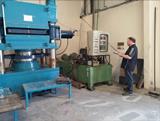Bridge bearing design starts with a bearing schedule and bridge designer is responsible to prepare one, which should contain vital information like detailed list of forces, movements and performance characteristics which is directly from design of bridge or structure.
Bridge bearing designs have followed one or combinations of following specifications.
AASHTO LRFD Bridge Design Specifications, Customary U.S. Units, 7th Edition, with 2015 Interim Revisions. AASHTO LRFD Bridge Design Specifications are intended for use in design, evaluation, and rehabilitation of bridges, and are mandated by the Federal Highway Administration for use on all bridges using federal funding. These Specifications employ the Load and Resistance Factor Design (LRFD) methodology using factors developing from current statistical knowledge of loads and structural performance.
AASHTO M215-2006
AASHTO M 251-2006 standard specification for plain and laminated elastomeric bridge bearings This specification covers material requirements for plain and laminated elastomeric bridge bearings. Elastomeric bearings furnished under this specification shall adequately provide for thermal expansion and contraction, rotation, lateral and transverse movements of bridge structure.
BS 5400 – British Standards.
BS 5400 is British Standard code of practice for design and construction of steel, concrete and composite bridges, which is applicable to highway, railway and pedestrian bridges. BS 5400 standard includes specification and calculation of standard bridge loads, application of limit state principles,[4] analysis, and fatigue load calculation[5] and reservoir method for fatigue load cycle counting.[5]. BS 5400 standard also specifies requirements and code of practice[1][2] on design of steel,[1] concrete (reinforced, prestressed or composite)[2] and composite bridges that use steel sections (rolled or fabricated, cased or uncased)[3] as well as materials and workmanship in bridge erection.Some part of standard is partially replaced by BS EN 1337-2 (EN 1337-2), BS EN 1337-3 (EN 1337-3), BS EN 1337-5 (EN 1337-5) and BS EN 1337-7 (EN 1337-7), and replaced by BS EN 1337-4 (EN 1337-4) and BS EN 1337-6 (EN 1337-6) but remains current)
BS EN 1337-3:2005
After formation of European Union in 1999 BS 5400 has been amalgamated into BS EN 1337-5:2005 which specifies requirements for design and manufacture of elastomeric bridge bearings, pot bearings and ptfe Teflon sliding bearings.
Australian Standard ™ Bridge design Part 4: Bearings and deck joints -AS 5100.4—2004 AP-G15.4/04.
This Standard was prepared by the Standards Australia Committee BD-090, Bridge Design to supersede HB 77.4—1996, Australian Bridge Design Code Section 4: Bearings and deck joints and AS 1523, Elastomeric bearings for use in structures. The AS 5100 series represents a revision of the 1996 HB 77 series, Australian Bridge Design Cod, which contained a separate Railway Supplement to Sections 1 to 5, together with Section 6, Steel and composite construction, and Section 7. AS 5100 takes the requirements of the Railway Supplement and incorporates them into Parts 1 to 5 of the present series, to form integrated documents covering requirements for both road and rail bridges. In addition, technical material has been updated. This Standard is also designated as AUSTROADS publication AP-G15.4/04.
Above standards are available to purchase from internet through authorized sellers as they all come under copy compliance- copyright requirements and please follow basic guidelines in copying them:
Bridge bearing design calculation starts with a bearing schedule and bridge designer is responsible to prepare bearing schedule, which should contain vital information like detailed list of forces, movements and performance characteristics which is directly from design of bridge or structure.
On receipt of above inputs in a formal Bearing schedule ( which can be downloaded from downloads, ) bearing designer -normally manufacturer side - use information received to determine design values with full specification. Most useful and informative schedule template given for bearing design, is in Table B.1 Annex B of BS EN 1337-1[1] or can find similar schedule in AASHTO LRFD.
For bridge bearing design calculations, required design criteria includes:
• Longitudinal and transverse movement
• Longitudinal, transverse, and vertical rotation
• Longitudinal, transverse, and vertical loads
• Shear modules used in structure design
• Maximum vertical deflection – based on structure design
• Longitudinal and transverse shear stiffness
To meet AASHTO or BS EN requirements following design steps - checks - are to be followed meticulously and a well-defined design calculation sheet will be submitted to bridge designer for approval of bearing type and size.
1 - Obtain Design Criteria
2 - Optimum Bearing Type
3 - Preliminary Bearing Properties.
4 - Design Method A or B as per AASHTO LRFD
5 - Compute Shape Factor -
6 - Compressive Stress -
7 - Compressive Deflection -
8 - Shear Deformation -
9 - Rotation or Combined Compression and Rotation
10 - Stability
11 - Reinforcement
12 - Design for Anchorage
13 - Design Anchorage for Fixed Bearing
14 - Draw Schematic of Final Bearing Design
Above bridge bearing design calculations steps clearly shows that bridge bearings sourced from any bridge bearing manufacture offering bearing sizes without design sheet will only end up Project in disaster. Indicative dimensions of bearings provided in our catalogue are only indicative and only for reference.
Sourcing bearing size and structure designed by pretread.com- and later our design calculation sheets of pretread.com passed over to alternative manufacture has reported to end up in grave disaster, as our designs are based on many years of experience in design manufacturing prototyping and testing, superior quality of rubber neoprene compound and rigorous post production testing and bridge inspection followed. Contact us to design correct bearing for your Projects with bearing schedule.
Thank you
![]() Services
Services ![]() Bearings Design & Load calculations
Bearings Design & Load calculations 